GET INSPIRED
In the exhibition Subspontaneous: Francesca Lohmann and Rob Rhee, Seattle-based artist Rob Rhee creates sculptures with gourds. Have you ever seen a sculpture made out of a gourd?
A sculpture is a three-dimensional form that you can look at from different directions.
Gourds grow on vines and are technically fruits that belong to the same family as pumpkins, cucumbers, squash, and melons. Gourds were among the first plants grown by people. Some have smooth skin while others have bumps. Gourds are not edible because, in addition to their tough skin, they contain lots of seeds and very little flesh. Instead, people use gourds for decoration or to make musical instruments, masks, containers, and art out of them.
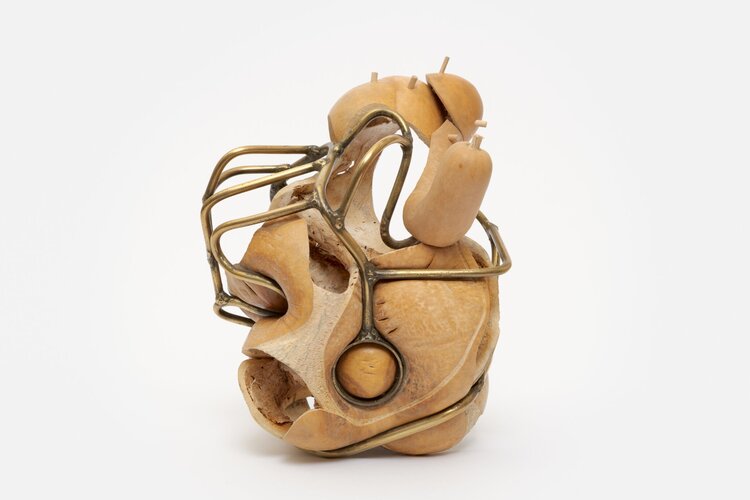
Rob Rhee. Typecast OOO, 2019. Cultivated gourd, brass plated steel, pegs. 8 x 9 x 11 in. Courtesy of the artist. Photo: Jueqian Fang.
Let’s take a close look at this sculpture. What do you see that’s going on here? In addition to the gourd, what’s another material that you recognize? Perhaps you noticed a metal cage. The artist Rob Rhee works with a local farmer, who grows these gourds inside of the metal cages that Rhee builds. Over time, the gourds take on different shapes within these man-made constraints as they grow, sometimes protruding through spaces in the metal.
In this case, the artist cut a few openings and then reconstructed the gourd by reattaching the cut pieces. See if you can find the areas that he cut out. What about the pieces that he reattached? Do you spot them?
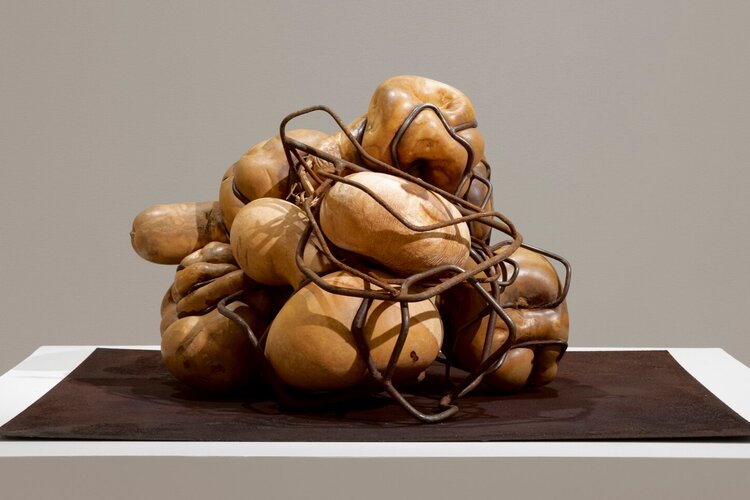
Rob Rhee. Untitled, 2019. Cultivated gourds, mild steel. 16 x 24 x 21 in. Courtesy of the artist. Photo: Jueqian Fang
Here is another sculpture by Rob Rhee. This one is a lot bigger than the previous one. This artwork is made out of multiple gourds growing on top of and around the metal structure that he fabricated. How many gourds do you think there are?

Rob Rhee. Untitled, 2019. Cultivated gourds, mild steel. 16 x 24 x 21 in. Courtesy of the artist. Photo: Jueqian Fang
Here is a different view of the same work. What does this remind you of? If you were to give it a title, what might you call this work? If the gourds could speak, what do you think they might be saying?
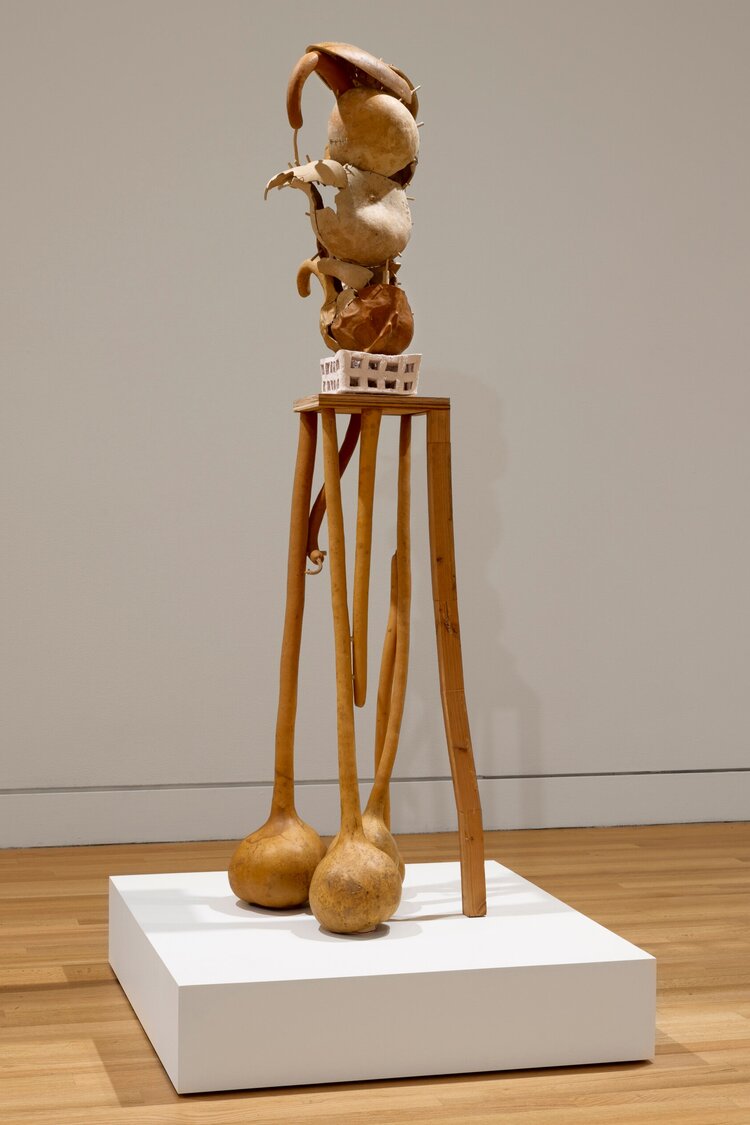
Rob Rhee. X I P E, 2019. Gourds, pine, gourd sherds, copper wire, brass screws, pegs. 65 x 17 x 15 in. Courtesy of the artist. Photo: Jueqian Fang
Let’s take a look at another sculpture. How is this artwork different from the others? What’s the first word that comes to mind when you see it?
Unlike the previous sculpture, these gourds grew separately, and the artist put them together to create this piece. How do you think he assembled them? With glue? Or maybe tape?
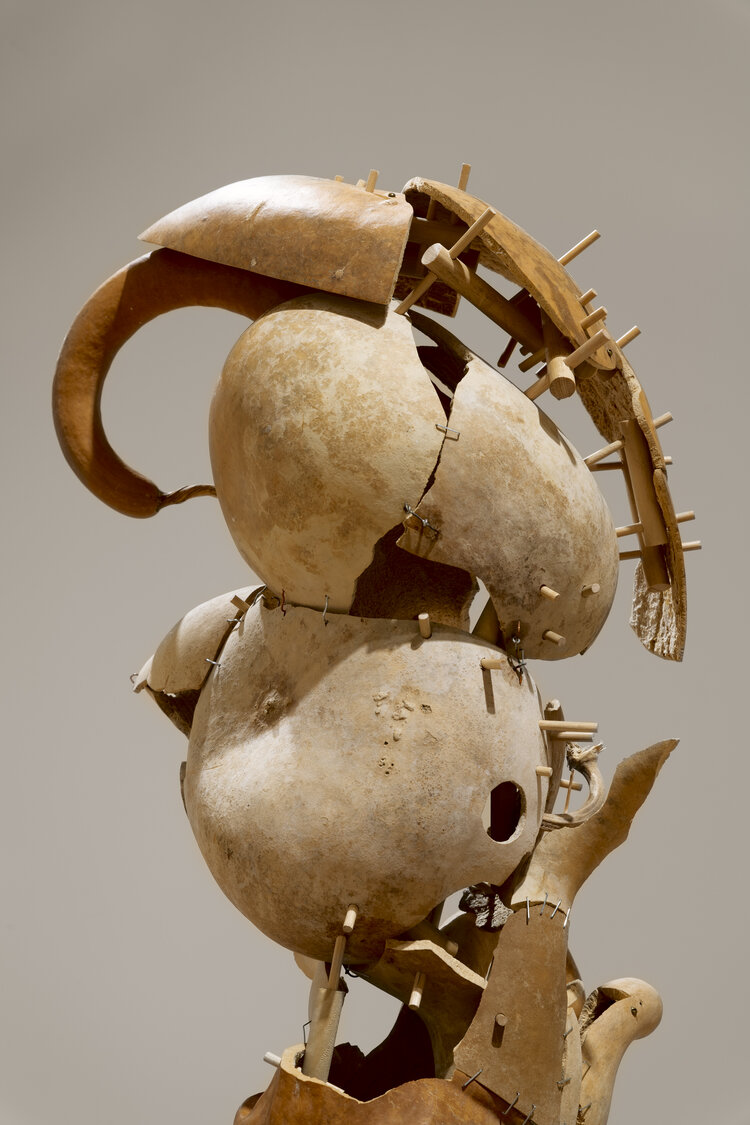
Rob Rhee. X I P E (detial), 2019. Gourds, pine, gourd sherds, copper wire, brass screws, pegs. 65 x 17 x 15 in. Courtesy of the artist. Photo: Jueqian Fang
Here is a close-up view of the sculpture. Look back at the previous images. Which part of the sculpture is this? It looks like the artist used some wooden pegs and staples to assemble the top part of this sculpture. Looking at this closely, what does it make you think of?
MAKE SOME ART
Now, it’s your turn to make some art! Go to your kitchen and find a fruit or vegetable that interests you. Maybe you have a pumpkin or squash lying around. If you do, can you see how they are related to the gourds?
Take a close look at your selection. What kinds of lines can you find? What shapes do you see? What about the textures? How might you describe it? What are some other details you notice—maybe a stem, a bump, or a bruise on the skin?
Now, grab a piece of paper and a pen or a marker, and let’s make a blind contour drawing of your fruit or vegetable. Without looking down at your paper, draw everything you notice, including all the lines, shapes, textures, and other details you see. No peeking until you’re done with your drawing! For an additional challenge, try completing your drawing with one continuous line!
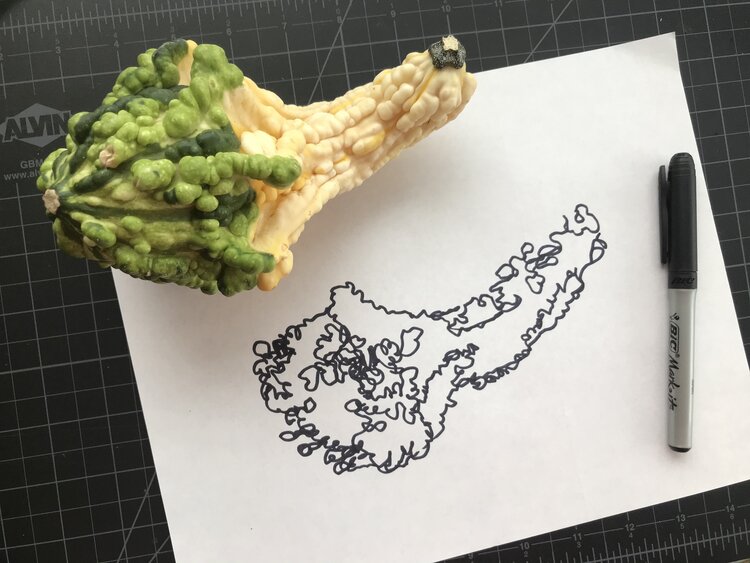
Photo: Lynn Chou
You can also download an activity sheet for this drawing exercise.
With a blind contour drawing like this, you are not always certain how the piece will turn out, and the surprise is part of the fun! The process of creating this drawing is more important than the finished product. If you don’t like how your drawing turns out the first time, try again and see what it looks like the second time!
If you are looking for another vegetable inspired activity, check out the Veggie Stamping tutorial.
SHARE YOUR WORK
Once you are done, please share your finished work with us on social media using #FryeFromHome. We cannot wait to see what your drawings look like!
Lynn Chou
Manager, Youth & School Programs